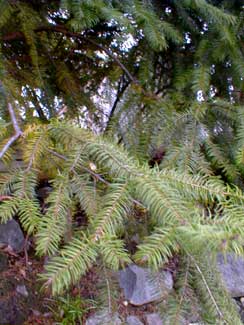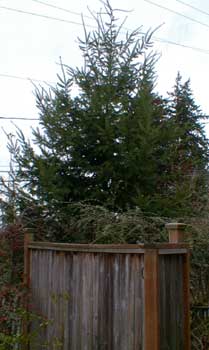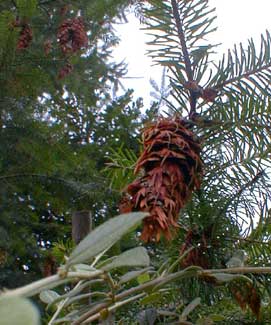 | |
| Here's a close-up of one of the lower limbs of our yard's Douglas-fir. Douglas-firs don't "self-prune" a great deal, being so sturdy that even trees vastly older than ours often retain lower limbs that drape to the ground. We underlimbed one side of this tree to reveal some of the trunk & to provide space for a shade-garden underneath. But this photo is on the sunny side facing the street, where we left limbs to drape down a sheer stone retainer wall, hanging even lower than the trunk. | |
Coastal Douglas-fir
Part II: Its Exploitation
"Those who look but do not see are unaware that every tree is dancing."
-Mevlana Jalaluddin Rumi
(1207-1273)
(1207-1273)
The Coastal Douglas-fir (Pseudotsuga menziesii var menziesii) provided the first & foremost incentive for white imigration to western Washington, which was among the last regions of a future United States to be taken from native peoples. Before the arrival of whites, aboriginal Americans did not fell these trees but made use of the blown-down wood for all manner of purposes.
Although fallen cedars were preferred for longhouses because cedar split easily into lumber using primitive tools & was impervious to rot even in the persistantly damp rainforests, the recovered wood of fallen Douglas-firs was used for all manner of implements such as bowls, spears, harpoon hafts & barbs, fire tongs, canoe-shaped burial caskets, as well as for fuel in longhouse firepits.
The sap had its uses, too. It was a calking for waterproofing canoes. It was used to saturate the tips of heartwood pegs to use as torches that would burn even in the rain. It was a medicinal salve providing a topical treatment for small soars.
This tree provided native peoples with a singular confection which was still made at least into the 1920s, & was known as "Douglas-fir sugar." The sugar was harvested from young branch-tips where it accumulated in the sunniest locations in the form of frost-like grains. These consist by of by weight 50% melezitose, which is a trisaccharide sugar. Our tree produces this frosty sugar each summer. I once took a half-teaspoon & dashed in into my mouth & can't say I found the flavor praiseworthy, but a people without cane or maple sugar handy for comparison would surely love it.
Another unusual use of Douglas-fir was in the preparation of barbecued dogfish. Ground up or powdery rotten wood was stuffed in the dogfish, then buried in firepit coals of the same wood to roast.
Coastal trees that blew from cliffs directly into the ocean were carried by the currents throughout the Pacific Ocean, so that Douglas-fir was gathered as driftwood by many island peoples. It was thereby an important resource for Polynesians who never saw the living trees. Douglas-fir was the preferred wood for Hawaiian war-canoes.
Sadly for this tree, whites discovered that the wood truly stood (or fell) among the world's finest of all trees for milled lumber, for plywood, & for all sorts of commercial uses. Douglas-fir today accounts for a full quarter of the lumber & timber industry in North America. Washington state's ocean coast & the coasts of Puget Sound were initially settled by whites primarily for the sake of harvesting Douglas-fir for distant transport by sea.
The oldest wooden houses along the whole of the Pacific Coast were frequently made exclusively of Douglas-fir, except for cedar shingles. As the country was further transformed by European settlers, railroad ties & telegraph poles were made from Douglas-firs, so that this tree became the glue that permitted such a vast continent to be reformed as a single nation.
Whites viewed these forests not as an essential part of an environment in which they were a well integrated part, but only as a resource to be exploited to the last degree. The vanished old growth forests of the many bays & coastlines frequently consisted primarily of Douglas-fir giants, because after many centuries, shorter-lived or less fire-resistant trees gave up ground to the Douglas-firs, with only shade-loving trees & shrubs in the understory. The first whites to arrive by ships were quick to remove these perfectly upright ancient giants, leaving not one tree in the wake of their saws, axes, & mills.
 Neither has modern advances in ecological knowledge much changed the habits of the Deforestry Industry. For twenty years of my life I would visit a swampy forest near Woodinville because of my interest in herpetology. The area had been a paradise for roughskinned newts, western toads, redleg frogs, tree frogs, brown seal salamanders, striped mole salamanders, lungless salamanders, & so on, besides an amazing array of birds & mammals. The old growth of this forest had long since vanished to lumberjack preferences, but what remained was nevertheless a wonderful big forest.
Neither has modern advances in ecological knowledge much changed the habits of the Deforestry Industry. For twenty years of my life I would visit a swampy forest near Woodinville because of my interest in herpetology. The area had been a paradise for roughskinned newts, western toads, redleg frogs, tree frogs, brown seal salamanders, striped mole salamanders, lungless salamanders, & so on, besides an amazing array of birds & mammals. The old growth of this forest had long since vanished to lumberjack preferences, but what remained was nevertheless a wonderful big forest.I'd never encountered an area with quite so extravagant an animal population. During the breeding season late in winer or early spring, you could within a few hundred square feet observe thousands of specimens of a half-dozen species of amphibians in a single hour, & even greater numbers of birds.
Then one winter's end I arrived to visit the breeding ponds only to find the entire forest had disappeared. All the foothills within sight were likewise denuded. The amphibian population dropped to nearly zero. In a swamp where every year would be found hundreds of softball-sized egg masses for the seal salamanders alone, there was not even one egg mass to be seen. Where breeding newt populations numbered thousands, I spotted fewer than a dozen.
The clearcut land had not so much as a scrub maple remaining; the breeding ponds & wetlands were deeply scarred mudslicks. Nor was this area to be replanted as foresters always pretend is their habit. The exterminated forest was platted out for sale lot by wretched lot, with already a few doublewides installed.
There was a little waterfall nearby that fed the formerly amazing breeding ponds for ducks, birds & amphibians. Three trees had been left arrayed around the falls. These were the only trees left of what had so recently been a forest. Apparently even the heartless lumberjacks needed to save one tiny spot alongside splashing waters, so they could have their own lunch hours apart from the hellish horror created by their own greedy destruction.
Individual Douglas-firs become old-growth within two or three hundred years, but really it takes a full one thousand years to repeat the process that results in a complete old growth forest environment dominated by these giants. So for all intent & purposes, every forest lost, even those few which are replanted for further harvests in twenty year cycles, are lost eternally.
 Driving along coastal highways of Oregon one encounters miles & miles of unbroken single-species forests with all the trees most unnaturally matched in size. These are destined to become lumber as soon as they are tall enough, & in the meantime they are a poor substitute for a varied & ecologically balanced forest. And wildlife is aggressively exterminated. Such beasts as brown bears, beavers, & porcupines are killed because of the damage they can do to the profitability of the next scheduled clearcuts. So even when the Deforestation Industry actually does replant two trees for every one they cut down, rather than selling the clearcut land for tract housing & trailer parks, they fail to mention that their replanted forests are not diverse, ecologically sound, nor populated by a full & proper range of natural wildlife.
Driving along coastal highways of Oregon one encounters miles & miles of unbroken single-species forests with all the trees most unnaturally matched in size. These are destined to become lumber as soon as they are tall enough, & in the meantime they are a poor substitute for a varied & ecologically balanced forest. And wildlife is aggressively exterminated. Such beasts as brown bears, beavers, & porcupines are killed because of the damage they can do to the profitability of the next scheduled clearcuts. So even when the Deforestation Industry actually does replant two trees for every one they cut down, rather than selling the clearcut land for tract housing & trailer parks, they fail to mention that their replanted forests are not diverse, ecologically sound, nor populated by a full & proper range of natural wildlife.An old growth forest still exists inside the city limits of Seattle, at Seward Park, but these are trees mainly 200 years old or younger, & not the largest of the large. One of the last truly gigantic old-growth Douglas-fir within Seattle once stood in Ravenna park near the University District & was called the Roosevelt Tree after Teddy Roosevelt, who established the first national wilderness forest on the Olympic Penninsula in great part because of his love of the virgin forests. Despite the fame of the Roosevelt Tree; despite thirty years of continuous activism to keep the last treasured giants in Ravenna, in 1913 while activists' guard was down, the Roosevelt Tree was cut down & sold as firewood.
Park superintendent J. W. Thompson claimed after-the-deed that the tree was rotten & a threat to public safety. When a University forestry professor investigated stumps to reveal the lie, & reported that several other old growth trees were likewise needlessly cut down, Thompson promised the citizens no further cutting would be done. Among the trees not yet destroyed was one named for Robert E. Lee, for which the community once again let its guard down, mistakenly believing promises given would be honored.
The destruction of the park continued. J. W. Thompson was a drunkard who never did his job properly, was very likely taking bribes from mills, & would eventually resign his office in disgrace. But to great extent he ended his career as the sacrificial goat for callous politics favoring exclusively business interests. In the wake of Thompson's resigniation, the remaining old growth of Ravenna continued to be sold off tree by tree. Every time another of the giants fell, the community rose up in arms, to be again reassured it would never again happen, though it invariably did happen until by 1925 not even one of those old trees remained.
Old growth Douglas-firs continue to vanish even from protected areas, & here & there a designated "heritage tree" saved for posterity does not an old growth forest make. The federal government is increasingly rather than decreasingly amenable to selling off rarer & rarer public resources; & the largest lumber companies have been caught time & again (usually when it's too late to save the old growth) faking data in order to get permission from the government to clear-cut public lands or at least take out all the old-growth. To great extent the government willfully overlooks patent frauds & it is only ecology activists abetted by the occasional local official who ever bother to track down the evidence of deceit. But even when the government refuses the permission, poachers move in, & the same companies denied permission ultimately end up with the logs anyway.
The profit achievable by poaching a single tree vastly out-measures the likelihood of getting caught. Permission to legally remove a few trees from a specific area results invariably in additional trees quickly stolen, because once removed from protected areas, there is no investigative body capable of proving many illegal trees are mixed in with a few legal ones. Therefore botanists studying old growth sometimes keep the location of particularly awesome giants a secret, for if their existence became widely known, that tree would suddenly vanish. The desparation of environmentalists has caused them to literally live in small shelters up in the branches of beloved giants, or to imbed nails in trees to make them unsafe to cut with chainsaws. The industry can always outwait the activists, however, & do invariably win.
Thinking back to my childhood, my great-grandparents owned a piece of land that was backed up against Saltwater State Park. It had old-growth Douglas-firs on it. These trees had pet names like "Tiny's Tree" because that one marked the property line between my grandparent's land & the small-statured woman further along the forested canyon. These trees were thought of almost as pets, & were frequently mentioned on deeds. Because the land fell away at a sharp angle & could not be farmed, it was defacto virgin forest, & even if firewood was sometimes taken, none of the oldest biggest trees were ever harmed.
Several properties away, somewhere around 1959 or 1961, the trees were sold because someone needed quick cash. Everyone else who owned properties throughout that forest worried their trees might "accidentally-on-purpose" be taken, so everyone for miles around tied ribbons or colored ropes & placed signs on their beloved old growth trees warning lumberjacks to keep away from them. It was well known that lumberjacks as a matter of universal policy committed tree theft willynilly & always went right for the oldest biggest trees. But it was believed that no lumberjack would ever dare to claim "accidentally" to have harvested anything from properties that where so clearly marked, removing trees that the community had united to protect, informing the loggers very clearly where not to trespass.
But that ancient forest was in a deep canyon & impossible to guard closely. Virtually overnight, all the old growth timber for miles up the canyon were stolen. I remember as a child my amazement to discover Tiny's Tree was now a huge stump big enough around for a squaredance. The property owners were horrified by the eternally irrepairable theft & damage, but what could be done? No attempt to get justice was effective.
This sort of thing continues to this day. Not long ago in Humbolt County in Northern California, a community united to save important old growth Douglas-firs within their watershed. People tied themselves to the trees until a judge could issue an injunction against cutting down the old growth. With injunction in hand, the trees' guardians went home, & within six hours all the trees were removed. Even though the judge was outraged, it came down to duelling government entities, & those who profited by their extreme & habitual villainy got away with their crimes, laughing all the way to the bank.
In other forests activists have literally taken to living in the branches of trees in cleverly designed branch-tents. But the loggers just keep guard & wait for these tree-sitters to have a break between changes of the guard, & target most specifically & aggressively whichever trees are most loved. There seems to be no limit to their infamy. And when economic depression hits areas along, say, the Washington coast where all the forests are already clearcut & the mills closed down, do the suddenly impoverished lumbermen admit their own destructive methods put an end even to their own ability to make a living? Do they blame big-business that encouraged the lie that turning forested mountains into denuded mudslide areas is sustainable? No. They blame any & all endangered species, & set out with rifles & beer cooler to vengefully kill some spotted owls. They blame ecological activists who file suits when federal government gears up to sell off another allegedly protected wilderness area or gives away the trees in essential watershed areas.
Today instead of presidents like Teddy Roosevelt who desired to protect such treasures, we've had successive presidents who make any crazy-ass excuse to favor the deforestation industry. The latest excuse is the legitimate threat of wildfires, but this becomes only the leverage to poach foremost the oldest trees & pretend they were all taken only from firebreak zones. Safety becomes only the latest "spin" to continue what has been occurring all along without ever resulting in fire safety.
The hundreds of years it takes for these trees to become old growth will never ever again be permitted to take place. Nations rise & fall in that amount of time, & if future old-growth forests do ever manage to re-establish themselves, it will be when Canada & the United States become countries of ancient history, with the very race of humans dying out.
Return to:
Part I: Douglas-fir: Its Majesty